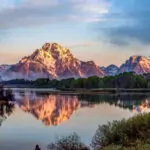The lake is not only for flood control. It attracts visitors for boating, camping, and fishing. Striped bass is the main draw—it’s the only lake in Texas where the species reproduces naturally. There are also largemouth bass, catfish, crappie, and bluegill.
Surrounding the reservoir are marinas, rental cabins, resorts, and state parks. Eisenhower State Park in Texas and Lake Texoma State Park in Oklahoma are two of the largest. The U.S. Army Corps also manages more than 50 recreation areas around the shoreline.
Every single one of these operators markets themselves with the name written correctly. Resorts, property ads, and tourism boards all keep it capitalized because it’s a brand as well as a place.
Updates From 2025
The reservoir is still very active. In May 2025, heavy rains forced the Army Corps to release about 43,000 cubic feet per second of water through the dam. By June 23, a new draw-down plan was announced to improve flood handling.
At the same time, new development came in:
- A solar-powered marina with 60 slips
- Tiny-home resorts near the spillway
- A 30-mile gravel bike trail called “Dam to Downtown”
Every press release, plan, and report spelled it “Lake Texoma.” Nobody left the “L” lowercase.
Wildlife and Environmental Role
Beyond fishing, the lake sits near Hagerman and Tishomingo wildlife refuges. Together they protect around 30,000 acres of wetlands. Birding, hunting, and conservation efforts depend on these areas.
Climate scientists expect flash floods to increase about 3% by 2035. Smarter dam gate systems are already being designed to handle this. In documents that describe these changes, the capitalization never drops.
Frequent Errors
- Writing “lake Texoma” with a lowercase “lake.”
- Reversing the order into “Texoma Lake.”
- Mixing lowercase and uppercase in the same piece of writing.
- Copying informal blog mistakes into academic or official work.
These errors reduce clarity and make writing look unedited.
How to Handle It Correctly
- Always use Lake Texoma in full.
- Keep it consistent throughout a document.
- Compare it with other lake names: Lake Michigan, Lake Mead, Lake Tahoe. Same format.
- If in doubt, check U.S. Army Corps publications or state park websites. They are the authorities.
FAQs
Is it ever acceptable to write “lake Texoma”?
No. Proper nouns require both words capitalized.
Why does capitalization matter for search engines?
Search indexing uses the most common, authoritative version, which is capitalized. Wrong casing weakens association.
Does government writing enforce it?
Yes. Every Corps of Engineers report and water agreement spells it “Lake Texoma.”
What about social media posts?
Informal writing may drop capitalization, but that doesn’t make it correct.
Is branding affected?
Tourism boards and local businesses rely on the capitalized form. It keeps the lake recognizable.
Conclusion
There’s no real debate here. The correct way to write the name is Lake Texoma. It’s a proper noun tied to a reservoir created by federal construction, recognized by two states, managed by the U.S. Army Corps, and promoted by entire industries around it.
Lowercasing “lake texoma” is an error that looks careless, weakens credibility, and can even reduce visibility online. For grammar, professionalism, and consistency with official use, keep it capitalized.
Author Bio
Jordon writes about geography, infrastructure, and digital publishing standards. He focuses on how proper naming and clear data presentation affect government records, online indexing, and tourism writing.

